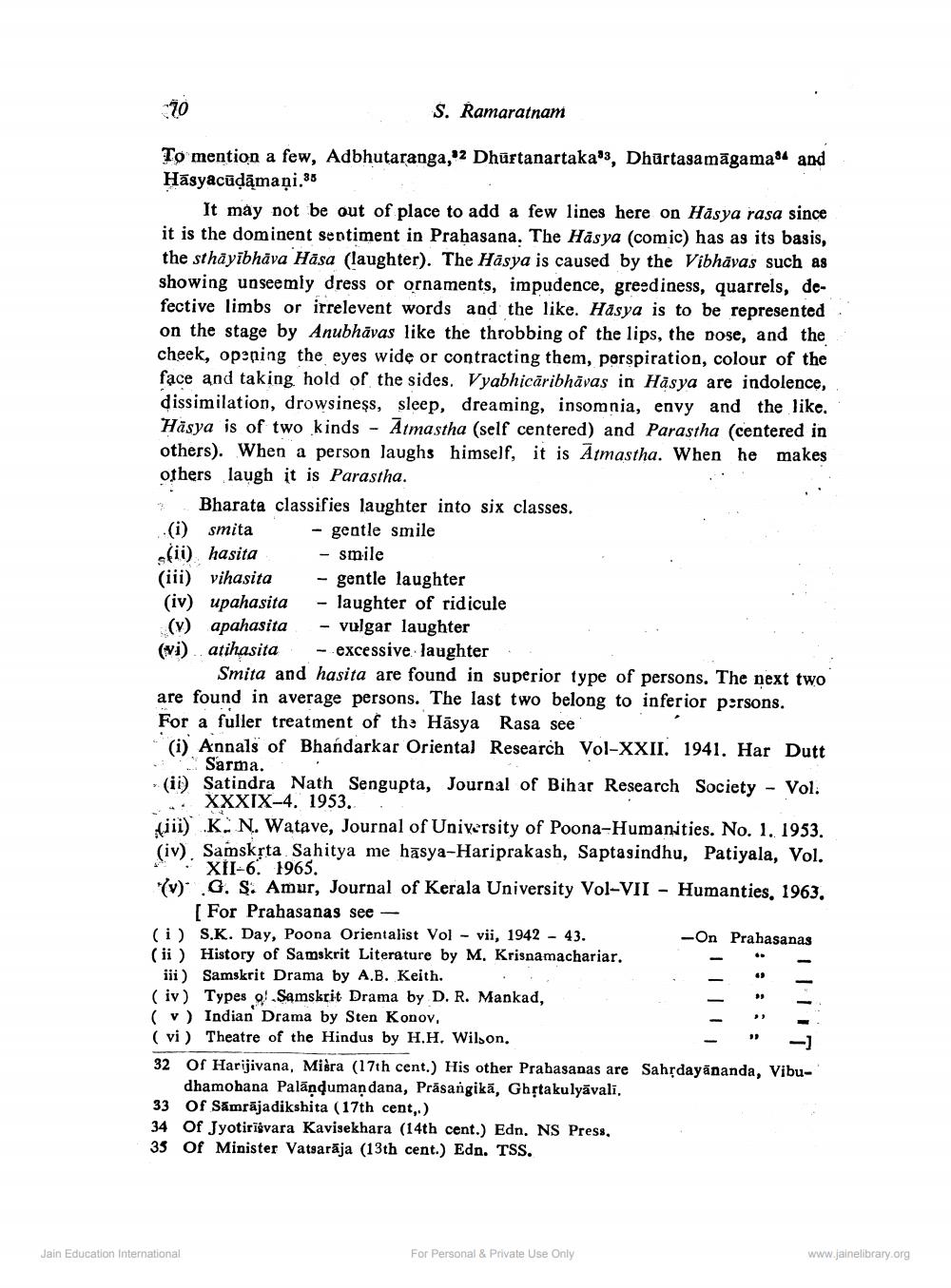________________
70
S. Ramaratnam
To mention a few, Adbhutaranga,"2 Dhūrtanartaka's, Dhürtasamāgama't and Hāsyacūdāmaņi.35
It may not be out of place to add a few lines here on Hasya rasa since it is the dominent sentiment in Prahasana. The Häsya (comic) has as its basis, the sthāyībhāva Hāsa (laughter). The Häsya is caused by the Vibhāvas such as showing unseemly dress or ornaments, impudence, greediness, quarrels, defective limbs or irrelevent words and the like. Hasya is to be represented on the stage by Anubhāvas like the throbbing of the lips, the nose, and the cheek, opening the eyes wide or contracting them, perspiration, colour of the face and taking hold of the sides. Vyabhicăribhāvas in Hāsya are indolence, dissimilation, drowsiness, sleep, dreaming, insomnia, envy and the like. Häsya is of two kinds - Ātmastha (self centered) and Parastha (centered in others). When a person laughs himself, it is Ātmastha. When he makes others laugh it is Parastha.
Bharata classifies laughter into six classes. (i) smita - gentle smile (ii) hasita - smile (iii) vihasita - gentle laughter (iv) upahasita - laughter of ridicule (v) apahasita - vulgar laughter (vi) atihasita -excessive laughter
Smita and hasita are found in superior type of persons. The next two are found in average persons. The last two belong to inferior persons.
For a fuller treatment of the Hāsya Rasa see * (i) Annals of Bhandarkar Oriental Research Vol-XXII. 1941. Har Dutt (ii) Satindra Nath Sengupta, Journal of Bihar Research Society - Vol.
XXXIX-4. 1953. , iii) K. N. Watave, Journal of University of Poona-Humanities. No. 1. 1953. (iv) Samskrta Sahitya me hasya-Hariprakash, Saptasindhu, Patiyala, Vol.
XII-6. 1965. (v) G. S. Amur, Journal of Kerala University Vol-VII - Humanties, 1963,
[For Prahasanas see - (i) S.K. Day, Poona Orientalist Vol - vii, 1942 - 43.
-On Prahasanas (ii) History of Samskrit Literature by M. Krisnamachariar.
iii) Samskrit Drama by A.B. Keith. (iv) Types o! Samskrit Drama by D. R. Mankad, ( v ) Indian Drama by Sten Konov, (vi) Theatre of the Hindus by H.H. Wilson. 32 of Harijivana, Misra (17th cent.) His other Prabasanas are Sahrdayānanda, Vibu
dhamohana Palāņqumandana, Prasangikā, Ghịtakulyävali, 33 Of Sámrājadikshita (17th cent,-) 34 Of Jyotiriĝvara Kavisekhara (14th cent.) Edn. NS Press, 33 Of Minister Vatsarāja (13th cent.) Edn. TSS.
Sarma.
ILIIT
Jain Education International
For Personal & Private Use Only
www.jainelibrary.org




